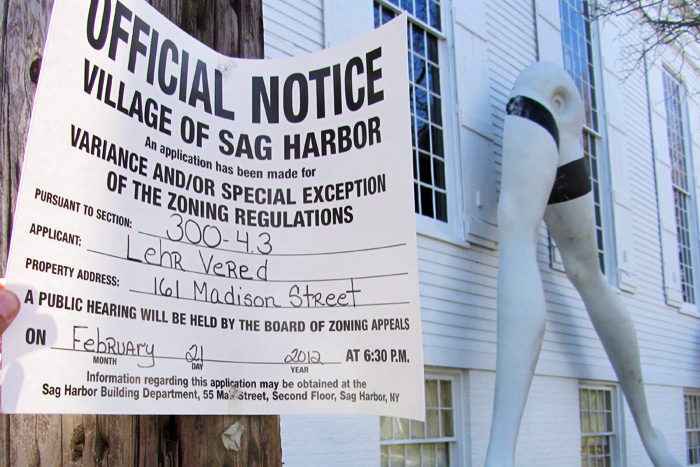Larry's Legs: They Came, They Saw, They Didn’t Conquer, They’re an Accessory Structure

In 2008, two women’s legs, very sexy-looking and very large, appeared on the side lawn of a private home where Madison Street meets Henry in the middle of the historic district of Sag Harbor. The legs were made of white fiberglass, sported stockings that came up to the upper thigh, and, way up high at the top, where building inspector Timothy Platt determined they were 16 feet 1 inch tall, they were connected at the hip.
The owners of the property, Ruth Vered and Janet Lehr, also the owners of an art gallery in East Hampton, had put them out there. They liked them. Some neighbors did not, thus the building inspector.
The house on this property next to the tall legs was originally built in the 19th century as a Bethel Baptist Church, made of white clapboard. Around 1950, this church became an art studio for the Sag Harbor painter Abraham Rattner. After that, it became an art school. One suspects that paintings were out on the front lawn on easels there at that time. In any case, the building was in bad shape when Vered and Lehr bought it. But they fixed it up and restored it and made it into their home. It seemed perfectly natural to them that a grand piece of sculpture by a famous artist whose works sell for millions, should be on their front lawn.
Building inspector Platt, however, deemed it an accessory structure, like a shed or pool house, and an accessory structure has to have a building permit, which this one did not. The laws for such a structure would require that it be less than 15 feet tall, and it wasn’t. It should also have been at least 35 feet from the property line, and it was a foot from the property line. As a result of all this, Vered was sent a letter from the Village putting them on notice that they would need a building permit.
These legs were constructed in 1994 by Larry Rivers, who modeled them after part of “Forty Feet of Fashion,” a 1969 assemblage he made for the Smith Haven Mall. The assemblage objects were mounted together as a mural. The thing was 40 feet long and 20 feet high. Also mounted in the mural were giant fiberglass, kissable lips—six of them—several drawings, a clock, a bunch of other found objects of indeterminate origin, and other stuff of determinate origin.
The man who commissioned the work was one of the developers of the giant Smith Haven Mall in Lake Grove. His name was Leonard Holzer, and he was married to a wealthy socialite
by the name of Baby Jane Holzer, who in her youth had famously swung from a chandelier during a party in a mansion her parents owned in Southampton.
Anyhow, Leonard Holzer had persuaded his partners at this mall—at the time, it was one of the largest malls in America—to commission various artists and sculptors in the area to
adorn the vast lobby of that place at its opening, after which they would remain on permanent display.
It was quite an assemblage. $350,000 was set aside for the art in the project. Among the things created were not only this assemblage by Larry Rivers, but also a magnificent mobile by Alexander Calder.

These works of art went up, and remained up for years, until first part of the Calder got disconnected and lost and then, when a later owner of the mall got in a fight with Rivers over the fact that Rivers wanted the “mural” donated to a museum, “Forty Feet of Fashion” was taken down and disassembled.
Different pieces of the mural got into the hands of art dealers as “Larry Rivers originals” which they were, and among them were these great long legs with the black garter nylon stockings. A casting was made of the legs and soon thereafter they came into the possession of Vered and Lehr, who thought, well, where shall we put them? How about right outside the windows?
Vered and Lehr were not happy with the designation assigned them by Sag Harbor Village. This was a sculpture, they said, not an “accessory structure.” Indeed, there are many examples of sculptures in and around the Hamptons, none of which needed permits. For example, for nearly 30 years a large granite sculpture by Jeff Parson called “Invitation” stood on the front lawn of the Dan’s Papers offices in Bridgehampton. But that was in Bridgehampton, not Sag Harbor.
Vered and Lehr tried to work with Sag Harbor. They applied for a building permit in 2011 and were denied. They applied for variances and they were denied in 2012.
Finally, in 2012 they filed a lawsuit in State Supreme Court claiming, among other issues, that their civil rights were being violated. Eastern Long Island has been, for 125 years, home to some of the greatest artists in the world. Jackson Pollock lived and worked here. So did Willem de Kooning, Thomas Moran, Fairfield Porter, Larry Rivers, Franz Kline, Roy Lichtenstein, the list goes on and on.
In the testimony about this case in the State Supreme Court, one neighbor, tired of looking out at these enormous legs, testified that the legs were nothing more than a marketing tool, Newsday reported. The owners had an art gallery. Here was the stuff they sold, on their lawn.
The argument should have had little merit. One could then argue that a Cadillac in the driveway of the home of a Chevrolet-Cadillac dealer was just the man hawking his wares.
But Judge Hudson quoted from this testimony in affirming the decision of the Sag Harbor Village Zoning Board of Appeals that these legs were an accessory structure. Here were other things he wrote.
“The ZBA properly found that something can be a structure and considered art at the same time.” He also said giving a variance to something just one foot off the property line would be a precedent “which would undermine the purposes of the Zoning Code.”
A hardship for the plaintiffs? “…any hardship that would result was self-created.”
Where does this go from here? At the moment Vered says she is discussing her options with her attorney, Stephen Grossman. And she finds it very hard to believe that the law, even on appeal, has turned their case down.
One could attempt to take this to the Supreme Court. But it would be expensive to try. And there’s no guarantee the Supreme Court would even take it.
I would remind Vered and Lehr that in East Hampton Town, where many of the great artists lived and some still live, it is against the law to build an unattached art studio in your backyard unless you deliberately do not put either a kitchen or running water in it. No toilet, no sink, no stove. That’s the only way one can be sure that the artist is real, and not just someone pretending to be a real artist who’s goal is to rent the place out for the summer.
Real artists starve, shiver in the cold, and run to the house when they have to go. In East Hampton, anyway.
Of course you could build an enclosed hallway between the studio and the house. Just part of the house, thank you very much.
The artists claim that what gives them the big creative rush in the Hamptons is “the light,” which is hazy and muted, much like in the South of France. As for the bureaucrats? Bah!



